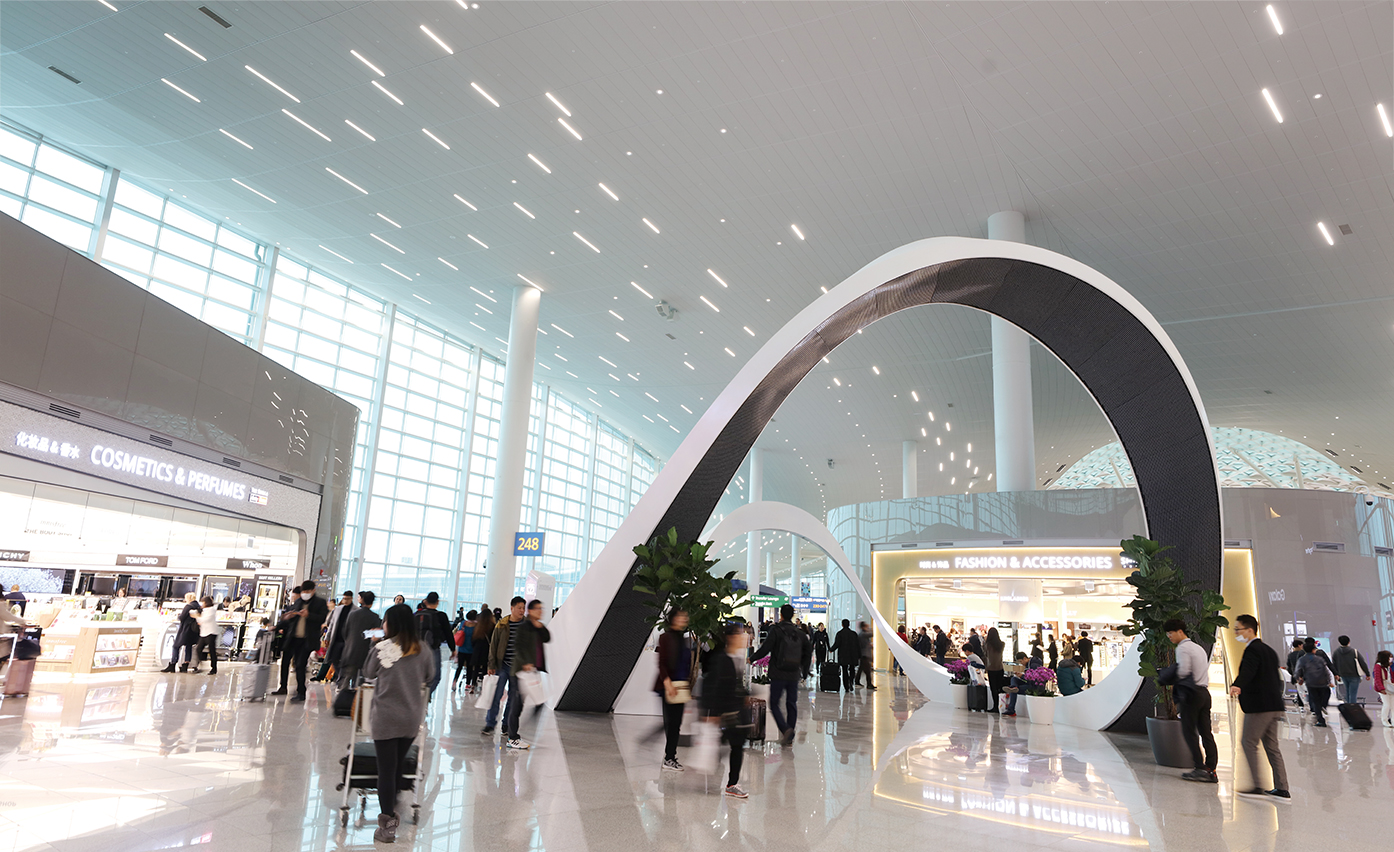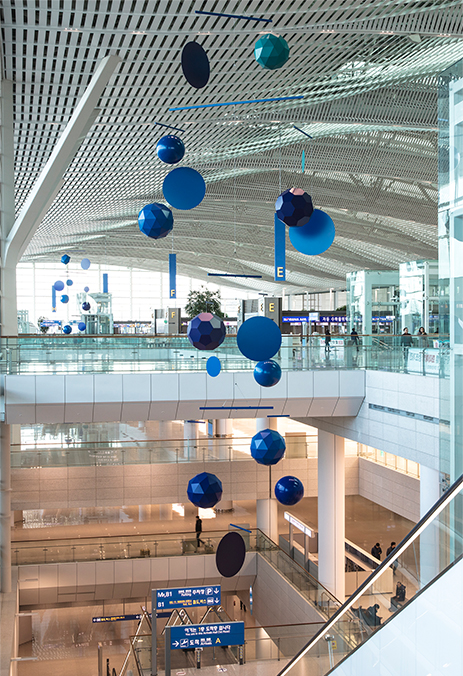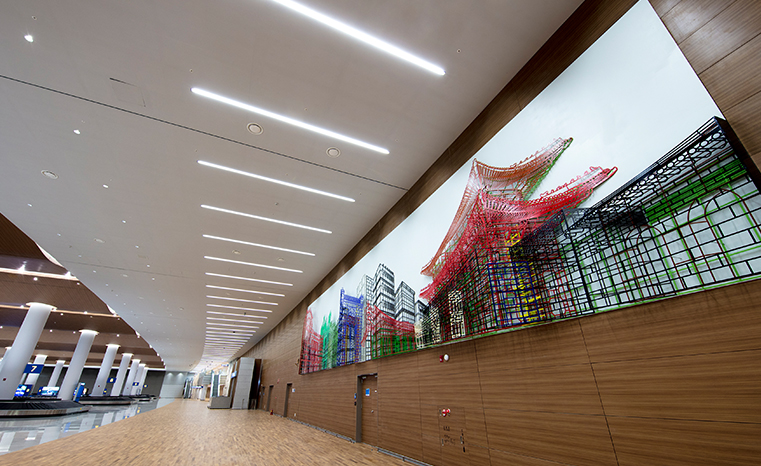
Contents





Architect Who Seeks to Transform Life






Unforgettable First
Impression of Korea
Terminal 2: Where the Environment and Art Coexist
Alain de Botton, a Swiss-born British philosopher and author, once said, “If I have to show the place that best represents our modern civilization to an alien from Mars, it will have to be an airport.” The airport today is more than just a gate travelers need to pass through to reach a destination. Incheon International Airport combines state-of-the-art eco-friendly technology, plants and arts to create a synergy and ensure that visitors get the best-possible first impression of Korea.
Written & Photographed by Incheon International Airport Corporation Media Relations Team

State-of-the-Art Terminal 2
What international visitors see at Incheon International Airport forms their first impressions of Korea. Terminal 2, which was opened in January 2018, broke the record for the number of daily passengers and welcomed ten million international visitors in 200 days. The terminal’s design also earned it a domestic architecture award for the second consecutive year.
Terminal 2 made full use of the experience and ideas the airport corporation has accumulated since the airport opened in 2001. Terminal 2 is considered to have accomplished efficient operation and the best customer service, with maximum passenger convenience, better flow of transit passengers and baggage, and eco-friendly elements. The departure and arrival gates and the waiting zone at security checkpoints are three times larger than those of Terminal 1, providing a better user environment. The departure room is 24 meters tall, or four meters taller than that of Terminal 1, allowing a more open and relaxing space. Other highlights of the new terminal include maximum efficiency in lighting, ventilation and insulation, and use of renewable energy sources such as solar or geothermal power. Using certified environmental products and materials, the energy efficiency is increased up to 40 percent in comparison with Terminal 1.
The new facility has received G-Seed Grade 1, the highest rating of the Green Standard for Energy and Environmental Design, earning perfect scores in the materials, resources and maintenance categories. G-Seed is the Korean Green Building Certification System that identifies and certifies eco-friendly public buildings with a combined area of more than 3,000 m2.
 The high ceiling is finished with spatial design, and plants and flowers grow in every corner of the airport.
The high ceiling is finished with spatial design, and plants and flowers grow in every corner of the airport.Smart Eco-Port
A distinguishing feature of the new terminal is the unique approach toward airport construction, including its “smart, green and eco-port.” Eco-friendly elements have been adopted to keep pace with global standards for energy and the environment. Information and communications technology (ICT) aims to build a “smart airport” by enabling anyone to use the airport more easily and quickly.
Landscaping was done with dense green plants and trees under the theme of “an airport that provides breath and rest,” an overall area three times that of Terminal 1. After clearing security checks, passengers arrive at the terminal node, where duty-free shops and shopping malls are complemented by wide vegetation across the area. At the center of airside, landscaping in Terminal 2 shows the airport’s prioritization and initiative of the green environment.
In particular, big and straight pine trees at Terminal 2 serve as a longitudinal guide of the terminal along 1 km of the 2.3 km straight section at the entrance located far from the passenger terminal. The rest of the areas close to the passenger terminal maintain an open view and create a vista to accentuate the beauty of Terminal 2. Each section—Welcome Zone, Water Zone, Green Zone—serves specific purposes, also creating different road views depending on the speed of the movement. Through these efforts, Terminal 2 is an “airport in a park” utilizing interior landscaping and entry roads with the building exterior. The plants and trees inside the airport are also carefully watered and managed not by automatic sprinkler systems but human hands.
 Artworks at Incheon International Airport leave the impression that the space is ready for visitors.
Artworks at Incheon International Airport leave the impression that the space is ready for visitors.Art-Port
Waiting for a flight is never boring at Incheon International Airport thanks to more than 16 artworks across 54 places to view all around Terminal 2. The cultural space Great Hall holds regular cultural performances that passengers can enjoy on the stair seats.
“Great Mobile” by the French artist Xavier Veilhan is exhibited at the third-floor departure gate as a landmark of the “art-port.” “It delivers a natural slow movement by air. I wanted this movement to present a poetic experience to travelers,” he said.
The hallway going from customs and immigration to the boarding gates features the media façade. “Wings of Vision” by Korean-American artist Jinnie Seo reflects the flow of time and light from sunrise to sunset. “I wanted to play the symphony of clouds,” she said. Her work shows clouds on a brisk morning on the east side and the warm light of sunset clouds on the west side.
The first thing passengers encounter as soon as getting off the plane is the artwork “Bit. Fall,” in which water falls in the shape of letters and words. The roar of the “water word drops” freshens up the space. An algorithm program developed by German artist Julius Popp automatically chooses the words. This program is connected to the internet, gauges the number of the words posted on the newsfeed, prioritizes them, and selects the letters and words to be shown in the exhibit.
 “Great Mobile” by the French artist Xavier Veilhan
“Great Mobile” by the French artist Xavier Veilhan “Ambiguous Wall” by Korean artist Kim Byung-joo symbolizes Seoul landmarks.
“Ambiguous Wall” by Korean artist Kim Byung-joo symbolizes Seoul landmarks.On the other side lies “Ambiguous Wall” by Korean artist Kim Byung-joo. This work symbolizes the Seoul landmarks of Gwanghwamun Gate, the old Seoul Train Station and Dongnimmun Gate. The interior and exterior designs of all buildings combine rows of stainless steel. Each building is structured in a unique way, catching the attention of people even from a distance and drawing them closer to it.
The never-ending redesign and renovation of the airport are intended to maximize the experience of passengers and make the airport more than just a transportation center. Under its new concept of combining art and airport, the airport highlights its additional role as a cultural hub as much as its fundamental role as an air hub. As the first and last place travelers visit in Korea, Incheon International Airport seeks to ensure a more dynamic and beautiful experience in the country.
Other Articles





Architect Who Seeks to Transform Life





Application of subscription
Sign upReaders’ Comments
GoThe event winners
Go


 January 2019
January 2019


